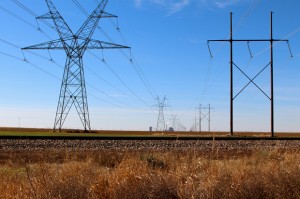
Meers area resident Bill Cunningham looks for haze over the Wichita Mountains from the top of Mt. Scott.
Logan Layden / StateImpact Oklahoma


Meers area resident Bill Cunningham looks for haze over the Wichita Mountains from the top of Mt. Scott.
Logan Layden / StateImpact Oklahoma

Logan Layden / StateImpact Oklahoma
Meers area resident Bill Cunningham looks for haze over the Wichita Mountains from the top of Mount Scott.
Federal regulators are forcing Oklahoma’s largest electric utilities to lower emissions at their coal-fired power plants or shut them down. The goal of the U.S. Environmental Protection Agency’s Regional Haze Rule is to clear the air on federal lands like national parks.
Several other states are dealing with similar regulations, but not Texas. And it’s having an effect at the Wichita Mountains Wildlife Refuge just across the border, near Lawton, the only qualifying federal site in Oklahoma.
Local Bill Cunningham, an avid hiker and chief of the Meers Volunteer Fire Department, says his view of the nearby peaks is obstructed most days.
“It’s just a haze hanging in the air,” he says. “It’s kind of a white film you can see on that southern horizon. And it lingers and persists.”
A cold front has cleansed the air on the day when StateImpact visited, but from the top of the highest point in the Wichita Mountains — Mount Scott — looking southwest into Texas, you can see the haze.
Cunningham doesn’t know what caused he haze. It could just be dust. He says when the wind is right, it can be smog from Dallas. But he also points at another possible culprit.
“I’m not a scientist. I’m not an activist. But I will tell you there is a big coal-fired power plant in Vernon, Texas about 50 miles southwest of here,” Cunningham says.
Al Armendariz, however, is a scientist — and an activist.
The former Southern Methodist University professor’s stint as an EPA administrator was short lived. He resigned as the director of Region 6, which includes Oklahoma, after a controversial comment he made comparing his approach to dealing with coal plants to Roman crucifixion surfaced.
Now he works with the Sierra Club’s Beyond Coal Campaign.

roy.luck / Flickr
Power lines extend out from the Oklaunion coal-fired power plant near Vernon, Texas.
“Pollution doesn’t recognize state boundaries,” Armendariz says. “And scientists have known for years that our pollution from Texas blows north over the Red River and impacts Oklahoma.”
He says the pollution from Texas is particularly bad.
“The Texas coal plants are truly some of the dirtiest in the country. In fact, just the largest two coal plants in Texas emit about as much sulfur dioxide as the ten largest plants in Arkansas and Oklahoma combined,” Armendariz says. “So they’re very dirty plants and yet they’re not being required to reduce their emissions the way that sources in Oklahoma have been required.”
Data from regional air quality monitoring groups, and Oklahoma’s Department of Environmental Quality actually show more of the pollution in the Wichitas comes from Texas than anywhere else, including Oklahoma.
So it seems unfair that Oklahoma, Arkansas and New Mexico could all be under the regional haze rule, while Texas isn’t.
Armendariz says it’s not that Texas isn’t subject to the rule, it’s just that states were in charge of coming up with their own plans for emission reductions, and the EPA hasn’t yet made a decision on the one from the Lone Star State.
“In Texas, the regional haze plan that the state regulators put together doesn’t require a single one of the 19 coal-fired power plants in Texas to install a single scrubber, or a single catalyst to reduce emissions,” Armendariz says.
Back at the Meers Volunteer Fire Dept., Cunningham says he doesn’t need science to convince him pollution from Texas could be blowing into the Oklahoma hills, he has his experience as a firefighter.
“In the early 2000s there was that huge series of wildfires in southern Mexico that the smoke was seen up in the Oklahoma panhandle and up into Kansas,” he says.
The EPA’s attention is now on Texas, and the federal agency is expected to reject — or accept that state’s haze plan in the coming months.
If recent history is any indication, the EPA with scuttle it in favor of its own plan, like the agency did in Oklahoma.